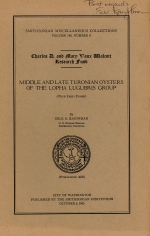Добрый день, Коллеги. Важное сообщение, просьба принять участие. Музей Ферсмана ищет помощь для реставрационных работ в помещении. Подробности по ссылке
Middle and late turonian oysters of the Lopha Lugubris group
Fossil oysters are among the most common and well preserved faunal elements in Cretaceous sediments. With few exceptions, however, they have been ignored in evolutionary studies and biostra-tigraphy. Although countless species have been described, the taxonomy of the group is confusing and inconsistent. It seems ironic, therefore, that they are one of the groups most suited to modern population systematics. The present investigation attempts to demonstrate the feasibility of detailed systematic and evolutionary study, faunal zonation, and regional correlation based on oysters. It employs simple biometric analysis of large collections, from numerous localities, distinct stratigraphic levels, and diverse sediment types. I have chosen for this purpose a typical lophid species group centered around Lopha lugubris (Conrad), and including L. bellaplicata bellaplicata (Shumard), L. bellaplicata novamexicana, n. subsp., and varieties of these forms.




